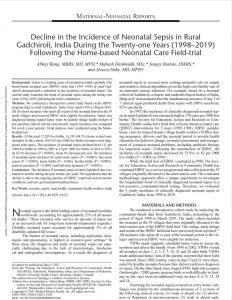
Background
Sepsis is a leading cause of neonatal mortality globally. The home-based neonatal care (HBNC) field trial (1995-1998) in rural Gadchiroli demonstrated a reduction in the incidence of neonatal sepsis. The current study examines the trend of neonatal sepsis during the twenty-one years (1998-2019) following the trial’s completion.
Methods
We conducted a retrospective cohort study based on the HBNC program data in rural Gadchiroli, India, from April 1998 to March 2019. All live-born neonates who spent all or part of the neonatal period in the 39 study villages and received HBNC were eligible for inclusion. Sepsis was diagnosed during regular home visits by trained village health workers if pre-specified clinical criteria were present. Sepsis incidence was computed for seven 3-year periods. Trend analyses were conducted using the Mann-Kendall test.
Results
Of the total 17,289 live births, 16,339 (94.5%) home visited were included. In this cohort, 1069 (65 per 1000 live births) neonates were diagnosed with sepsis. The incidence of neonatal sepsis declined from 111 per 1000 live births in 1998 to 2001 to 19 per 1000 live births in 2016 to 2019, an 82.9% decrease (P < 0.0001), mean 4% decrease per year. The incidence of neonatal sepsis declined for early-onset sepsis (P < 0.0001), late-onset sepsis (P < 0.0001), home births (P = 0.006), facility births (P < 0.0001), preterm neonates (P < 0.0001) and full-term neonates (P < 0.0001).